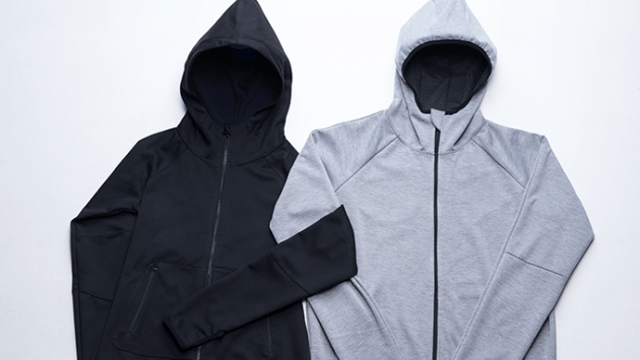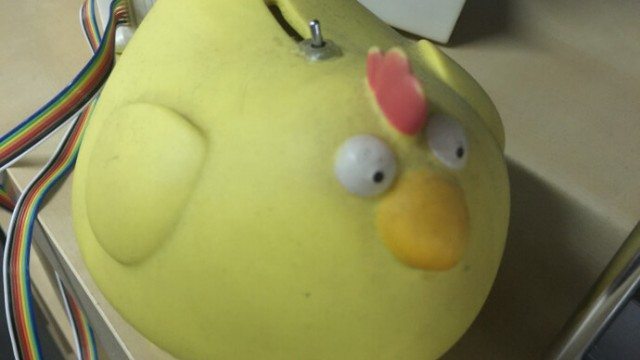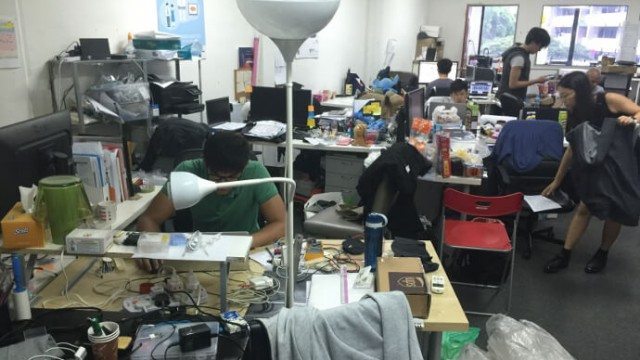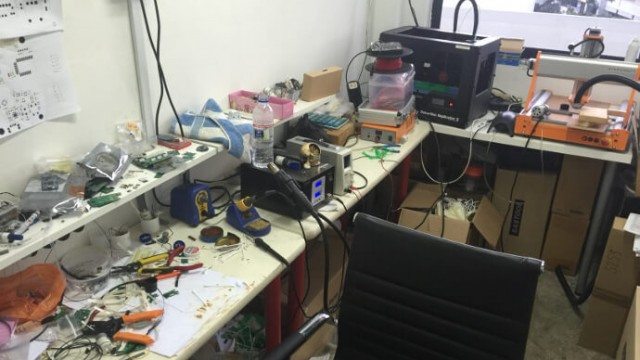The AiraWear project was founded on the back of literal pain points

When Singapore-based wearable tech startup TWare first hatched in 2011, it had one objective — to fit chickens with jackets.
Despite the adorable visual imagery it conjures up, the project — a joint collaboration between the Connective Ubiquitous Technology for Embodiments (Keio-NUS CUTE) center and TWare — was rooted in a grim practical reality: chickens are bred for human consumption. The team wanted to develop a more merciful way to give chickens the chop.
The idea for the chicken jacket was based off findings from animal researcher Dr. Temple Grandin, who found that putting cattle in squeeze boxes or machines help the cattle to feel calm before they are slaughtered, thus making the process more humane.
Using the same theory, the team designed the chicken jacket to accomplish the same goal.
“The chicken jacket is basically a remote hugging system, allowing a chicken to put on a jacket, while its owner remotely controls the hugging process via a model chicken,” says Ong Si Quan, a growth hacker at TWare in an interview with e27. The hugging system uses a mechanism known as ‘deep touch pressure’.

The team even made a model of a chicken, though this fella escaped the gallows
The next project led by TWare’s then co-founder and CEO James Teh was a whole lot less morbid. The remote hugging system was to be integrated into jackets (worn by humans) so couples separated by long distances can give each other hugs remotely. But, it faced setbacks, and out of it, another idea was spawned — one with a socially conscious bent.
“The idea was limited by the state of technology at that time. It was also during this period that Teh and the rest of the co-founders, Lai Sep Riang (also CTO) and Lin Wei Liang (now CEO), met an occupational therapist who told them that hugs are beneficial to children with autism,” says Ong.
Autistic people’s sensory functions behave a little different from other folks; this results in them being hyper sensitive to their surroundings.
You see, besides using the squeeze machine to calm cattle, Dr. Grandin, who happens to be diagnosed with autism too, found it to be soothing when she tried it on herself.
This led to the development of a squeeze machine for autistic people.
There are, however, a couple of limitations of this machine. It is expensive and too heavy to lug around (Note: Grandin has since developed lightweight vests).
Also Read: Singtel’s new initiative will see up to 7 social startups receive up to US$14.8K each
TWare worked to sovle this problem by developing the TJacket — a similar concept but with a focus on being highly portable.
While it was an effective product, the team was restless; they wanted to do more, think beyond niche markets and leverage on their hugging technology to develop a product for the masses.
“The founders wanted the touch technology to not just benefit people with autism, but the whole world. They wanted to reinvent the idea of comfort for everyone. Yet, creating a ‘hug’ jacket for everybody to hug themselves made no sense at that current point. Tware wanted to do more,” says Ong.
The next step
The TWare team went back to the drawing board to think about who else can benefit from this technology. But it didn’t take long for them to arrive at an answer. It was quite apparent, and as a matter of fact, literally right in front of their eyes.
The company’s CFO Dinos Demetriades is diagnosed with scoliosis, an impairment in the alignment of the spine; Tan Jun Yuan, the Product and Product Head, often suffers from back pain from sitting too long at his desk.
TWare thus set to task on its new project, a massage jacket dubbed AiraWear,

TWare’s office at Block 71
“Sore muscles, back pain, stiff shoulders are common problems affecting the majority of the working world, who spend countless hours hunching over their desks. I am referring to people like journalists, programmers, designers, and so on. Not only that, long flights and commutes contribute to even more backaches and postural problems. These are challenges we often ignore, but can lead to severe long-term consequences,” says Ong.
“We built AiraWear so that everyone has the opportunity to experience an affordable massage at any time without worrying about having to schedule time off to see a massage therapist, or fork out big bucks to purchase a massage chair,” he says.
Also Read: Lifesaving lessons from Reblood CEO: How social businesses balance between impact and sustainability
Despite having previously developed similar incarnations of the product, the team still faced hurdles making AiraWear. Its strength and intensity were significant hurdles.
“Initially, when we brought the jacket to CES 2016 in Las Vegas to gather feedback, we faced brutally honest comments that told us the strength wasn’t strong enough…through countless repeated experiments and development, multiple prototypes, we are glad to say that the strength of the modules are now strong enough, equivalent to the strength your masseuse can press on you. Of course, the strength is completely adjustable via the app,” says Ong.

The guts of an IoT startup
Besides controlling the intensity and strength of the massages, the app also displays four different massage routines.
The jacket weighs about same as a conventional winter jacket at 1.2 kilograms. It is made of high-tech composite materials such as TPU-coated Nylon fabric — which TWare claims is hardy enough to knead your muscles yet flexible to move around comfortably at the same time. A single full charge (which takes 2 hours) will give the user 3 hours of continuous usage. AiraWear currently retails at US$199.
Here’s a video of how it works:
Funding and the future
TWare has previously received funding from the angel investors at Singapore Center for Social Enterprise (raiSE), SPRING SEEDS as well as corporate funds.
It also turned to crowdfunding for AiraWear. It raised US$150,035 on Kickstarter and US$163,345 on Indiegogo to date. Ong says TWare is looking to raise a Series A round in the near future.
Several upgrades to AiraWear are in the pipeline.
Some of these include implementation of VR, more massage preset routines on the app, massage variations and other fitness tracking (heartrate and steps tracking, etcetera).
Also Read: This startup wants to support Indonesian youths’ social projects
Expounding on the VR integration, Ong says: “We intend to pair virtual reality cardboard sets with our massage jacket to create a relaxing environment. This means that users can be immersed in scenarios like a beach, a spa, in Bali, near rivers and mountains and so on for a full massage experience, even though they are totally just relaxing in the office or at home! Of course, we aren’t ruling out the possibility of using even more advanced VR headsets like Oculus Rift and etcetera in the further future.”
For many who foresee a lifetime spent in the cold embrace of swirly office chairs, the AiraWear may provide some relief.
—
Image Credit: AiraWear
The post First these Singaporeans designed jackets for chickens, then they made jackets that can massage you appeared first on e27.